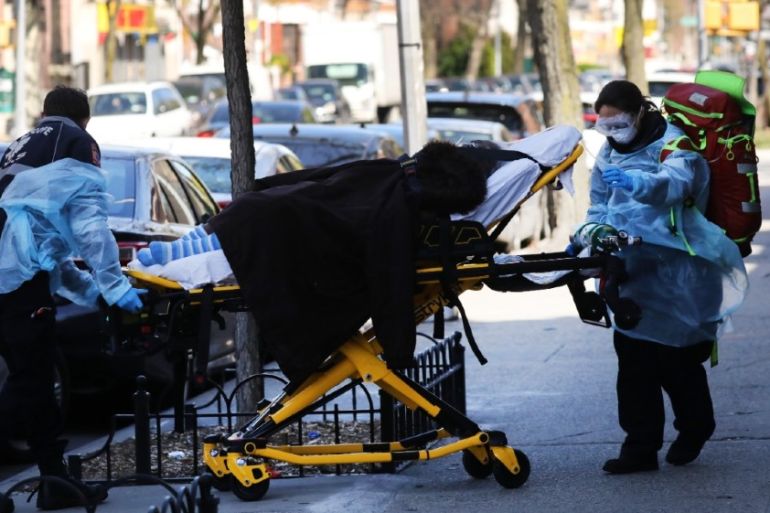US coronavirus death toll passes 20,000
The US has confirmed the highest number of deaths related to COVID-19 in the world amid more than 500,000 infections.

The United States has surpassed Italy for the highest number of coronavirus-related deaths in the world, reporting 20,071 fatalities according to a Johns Hopkins University tally on Saturday.
The grim milestone was reached as the country reported more than 500,000 cases and President Donald Trump mulled over when the country may see a return to normality.
Keep reading
list of 3 itemsYour coronavirus emergency kit: Five workouts to do at home
What happens if you catch the new coronavirus?
The pandemic’s centre of gravity has long since shifted from China, where the first cases were reported in December, to Europe and the US, which now has by far the largest number of confirmed cases.
Over the past week, the number of new deaths each day has been about three times higher on average in the US than in Italy. Deaths have risen more than 9,000 for the week in the US compared with fewer than 3,000 in Italy. The European nation on Saturday reported 619 new fatalities linked to COVID-19, bringing its death toll to 19,468.
About half the deaths in the US were in the New York metropolitan area. Speaking to reporters on Saturday, New York governor Andrew Cuomo said that 783 deaths were recorded in the state on Friday, bringing the total death toll in the state to 8,627. However, Cuomo also said that the rate of hospitalisations and intensive care admissions in the state continue to slow down.
But with authorities warning that the crisis in New York is far from over, the city’s mayor Bill de Blasio announced on Saturday that public schools in the city would remain closed until September.
“There is nothing easy about this decision,” the mayor said at a news conference. “It clearly will help us save lives … It’s the right decision,” de Blasio added.
The closing affects 1.1 million students in what is by far the country’s largest public school district.
Fears about the spread of the virus into the nation’s heartland are mounting as well. Twenty-four residents of an Indiana nursing home hit by COVID-19 have died. Chicago’s Cook County has set up a temporary morgue that can take more than 2,000 bodies. And Chicago Mayor Lori Lightfoot has been going around telling groups of people to “break it up.”
Trump mulls reopening
Trump is convening another taskforce on April 14 to decide when to move to reopen all, or parts of, the country in what he said would be “the biggest decision I’ve ever had to make”, he told reporters on Friday.
Public health experts have warned that the US death toll could reach 200,000 over the in the coming months if unprecedented stay-at-home orders that have closed businesses and kept most Americans indoors are lifted after 30 days.
“On one side, [Trump] has his corporate leaders and friends who are insisting that he open up the economy as soon as possible,” said Al Jazeera’s Mike Hanna reporting from Washington. “On the other hand, he has the health experts who are insisting that any premature opening, or even partial opening, could result in another spike in deaths from this ongoing pandemic,” Hanna reported.
Meanwhile, the administration is pulling back federal support of testing sites by the end of the week, raising concerns among governors who claim they still do not have enough test kits.
Trump insists that the country has done well by testing more than two million people, however, “experts argue that these figures are meaningless unless they are fixed to a per capita ratio, meaning how many per 1,000 persons have been tested,” Hanna said.
Trump has claimed that he took the virus seriously from the beginning. “I felt it was a pandemic, long before it was called a pandemic. All you had to do was look at other countries,” Trump said on March 10.
However, his public statements suggest otherwise. In January, as the World Health Organization warned of a global crisis and coronavirus in China grew, Trump banned Chinese citizens from travelling to the US, but downplayed the threat.
By late February, as the virus started to spread across various states, legislators on Capitol Hill publicly questioned the administration officials regarding whether or not resources had been stockpiled to deal with the crisis.
“It’s going to disappear. One day, it’s like a miracle, it will disappear,” Trump said on February 28.
However, the tone quickly changed and, on March 13, Trump declared a national emergency as the number of deaths related to the coronavirus rose to 40 amid 1,701 infections.
More than 16 million people have filed jobless claims in the past three weeks as the pandemic brought the US economy to a standstill.